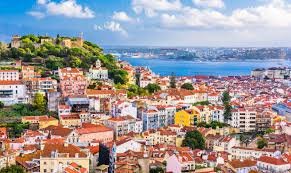Currently Empty: ₹0
Lisbon City of Seven Hills – Static GK for UPSC, SSC, Railways & Govt Exams
Introduction to the City of Seven Hills
Lisbon, the vibrant capital of Portugal, is famously known as the “City of Seven Hills” due to its unique geographical formation. Built over a group of steep hills that overlook the Tagus River, Lisbon blends historical charm with modern sophistication. This iconic title places Lisbon among other ancient cities like Rome and Istanbul, which are also built on seven hills.
Geographical Significance of Lisbon
Lisbon’s seven hills—São Jorge, São Vicente, São Roque, Santo André, Santa Catarina, Chagas, and Sant’Ana—offer not only scenic viewpoints but also play a vital role in the city’s layout, transportation, and urban architecture. These hills have historically influenced the city’s development, with buildings and roads designed to accommodate the elevations, creating a picturesque, maze-like layout.
Cultural and Historical Relevance
Each of Lisbon’s hills is steeped in rich cultural and historical significance. For instance, the São Jorge Hill is home to the famous São Jorge Castle, a Moorish-era fortress that has witnessed centuries of conquests. The Alfama district, nestled among the hills, is one of the oldest neighborhoods in Lisbon and is renowned for traditional Fado music and winding cobblestone streets.
Impact on Tourism and Economy
The “Seven Hills” title has significantly contributed to Lisbon’s tourism appeal. Tourists are drawn to its stunning miradouros (viewpoints), tram rides through hilly streets, and historic landmarks. This boosts the local economy, supports hospitality businesses, and promotes cultural awareness. Lisbon’s hills also provide excellent conditions for eco-tourism activities like hiking and urban exploration.
Lisbon in Modern Times
Today, Lisbon continues to thrive as a center of technology, education, and global diplomacy while maintaining its historical roots. Its hilltop architecture and panoramic vistas give it a unique charm, making it one of Europe’s most visited capitals. The identity as the “City of Seven Hills” remains a strong branding element in Portugal’s global cultural identity.

B)  Why this News is Important
Why this News is Important
Relevance in General Awareness
For aspirants of government exams, especially those preparing for civil services, SSC, or UPSC, knowing international geographical nicknames is a common part of the general awareness syllabus. Lisbon’s title as the “City of Seven Hills” is a potential static GK question that often appears in competitive examinations.
Boosts Geographical and Cultural Knowledge
Understanding why Lisbon is known as the City of Seven Hills helps students gain insights into geographical formations, urban development, and the significance of historical geography in shaping modern cities. Such facts enhance a candidate’s overall awareness and are frequently asked in exams under World Geography and Current Affairs sections.
C)  Historical Context
Historical Context
Ancient Origins of the Title
The tradition of identifying cities with “seven hills” dates back to ancient times. Rome was the first city recognized with this designation, setting a precedent that many cities, including Lisbon, later adopted. The seven hills of Lisbon were likely identified during the Roman and Moorish periods, where topography played a key role in defense and urban planning.
Influence on Urban Development
These seven hills shaped Lisbon’s historical development, from military strategy during conquests to artistic and cultural centers in the modern era. The layout of the city required specific architecture like terraced housing, trams, and steep stairways, giving rise to a unique urban identity that persists to this day.
D)  Key Takeaways from “City of Seven Hills – Lisbon”
Key Takeaways from “City of Seven Hills – Lisbon”
FAQs: Frequently Asked Questions
Q1. Why is Lisbon called the City of Seven Hills?
Lisbon is called the City of Seven Hills because it is built over seven prominent hills that overlook the Tagus River, which have played a historical role in its urban and cultural development.
Q2. What are the names of Lisbon’s Seven Hills?
The seven hills are São Jorge, São Vicente, São Roque, Santo André, Santa Catarina, Chagas, and Sant’Ana.
Q3. Is this title of “Seven Hills” unique to Lisbon?
No, other historical cities such as Rome and Istanbul also carry this title. It reflects historical significance and unique urban layouts.
Q4. How is this information useful for government exam aspirants?
It is part of static general knowledge often asked in exams like UPSC, SSC, CDS, State PCS, Railways, and Banking exams under the General Awareness or General Studies section.
Q5. Which hill is home to São Jorge Castle?
The São Jorge Hill is home to the famous São Jorge Castle, a key historical and tourist site in Lisbon.
Some Important Current Affairs Links





 Why this News is Important
Why this News is Important Historical Context
Historical Context Key Takeaways from “City of Seven Hills – Lisbon”
Key Takeaways from “City of Seven Hills – Lisbon”

